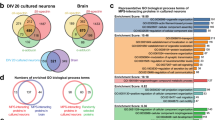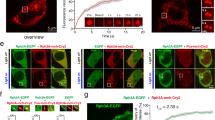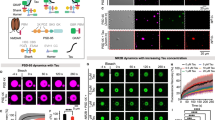Abstract
The postsynaptic density protein PSD-95 and related membrane-associated guanylate kinases are scaffolding proteins, whose modular interaction motifs organize protein complexes at cell junctions. The signature guanylate kinase domain (GK) contains elements of the protein's GMP-binding site but does not bind nucleotide. Instead, the GK domain has evolved from an enzyme to a protein-protein interaction motif. Here, we show that this canonical GMP-binding region interacts with microtubule-associated protein-1a (MAP1a) and we present a structural model. We determine the consensus GK-binding sequence in MAP1a and demonstrate that PSD-95 can use a similar interaction mode to bind diverse protein partners. Furthermore, we show that PSD-95 GK has adopted the conformational flexibility of the ancestral enzyme to bind its varied ligands, which suggests a mechanism of regulation.
This is a preview of subscription content, access via your institution
Access options
Subscribe to this journal
Receive 12 print issues and online access
$189.00 per year
only $15.75 per issue
Buy this article
- Purchase on Springer Link
- Instant access to full article PDF
Prices may be subject to local taxes which are calculated during checkout








Similar content being viewed by others
References
Kuriyan, J. & Cowburn, D. Modular peptide recognition domains in eukaryotic signaling. Annu. Rev. Biophys. Biomol. Struct. 26, 259–288 (1997).
Lu, C.S., Hodge, J.J., Mehren, J., Sun, X.X. & Griffith, L.C. Regulation of the Ca2+/CaM-responsive pool of CaMKII by scaffold-dependent autophosphorylation. Neuron 40, 1185–1197 (2003).
Van Petegem, F., Clark, K.A., Chatelain, F.C. & Minor, D.L., Jr . Structure of a complex between a voltage-gated calcium channel beta-subunit and an alpha-subunit domain. Nature 429, 671–675 (2004).
Funke, L., Dakoji, S. & Bredt, D.S. Membrane-associated guanylate kinases regulate adhesion and plasticity at cell junctions. Annu. Rev. Biochem. 74, 219–245 (2005).
Tavares, G.A., Panepucci, E.H. & Brunger, A.T. Structural characterization of the intramolecular interaction between the SH3 and guanylate kinase domains of PSD-95. Mol. Cell 8, 1313–1325 (2001).
McGee, A.W. et al. Structure of the SH3-guanylate kinase module from PSD-95 suggests a mechanism for regulated assembly of MAGUK scaffolding proteins. Mol. Cell 8, 1291–1301 (2001).
Woods, D.F., Hough, C., Peel, D., Callaini, G. & Bryant, P.J. Dlg protein is required for junction structure, cell polarity, and proliferation control in Drosophila epithelia. J. Cell Biol. 134, 1469–1482 (1996).
Hoskins, R., Hajnal, A.F., Harp, S.A. & Kim, S.K. The C. elegans vulval induction gene lin-2 encodes a member of the MAGUK family of cell junction proteins. Development 122, 97–111 (1996).
Harris, B.Z. & Lim, W.A. Mechanism and role of PDZ domains in signaling complex assembly. J. Cell Sci. 114, 3219–3231 (2001).
Brenman, J.E. et al. Localization of postsynaptic density-93 to dendritic microtubules and interaction with microtubule-associated protein 1A. J. Neurosci. 18, 8805–8813 (1998).
Szebenyi, G. et al. Activity-driven dendritic remodeling requires microtubule-associated protein 1A. Curr. Biol. 15, 1820–1826 (2005).
Kim, E. et al. GKAP, a novel synaptic protein that interacts with the guanylate kinase-like domain of the PSD-95/SAP90 family of channel clustering molecules. J. Cell Biol. 136, 669–678 (1997).
Tu, J.C. et al. Coupling of mGluR/Homer and PSD-95 complexes by the Shank family of postsynaptic density proteins. Neuron 23, 583–592 (1999).
Cho, W. Building signaling complexes at the membrane. Sci. STKE 2006, pe7 (2006).
Cho, W. & Stahelin, R.V. Membrane-protein interactions in cell signaling and membrane trafficking. Annu. Rev. Biophys. Biomol. Struct. 34, 119–151 (2005).
Nooren, I.M. & Thornton, J.M. Diversity of protein-protein interactions. EMBO J. 22, 3486–3492 (2003).
Reese, M.L. & Dötsch, V. Fast mapping of protein-protein interfaces by NMR spectroscopy. J. Am. Chem. Soc. 125, 14250–14251 (2003).
Frank, R. The SPOT-synthesis technique. Synthetic peptide arrays on membrane supports–principles and applications. J. Immunol. Methods 267, 13–26 (2002).
Gerrow, K. et al. A preformed complex of postsynaptic proteins is involved in excitatory synapse development. Neuron 49, 547–562 (2006).
Post, C.B. Exchange-transferred NOE spectroscopy and bound ligand structure determination. Curr. Opin. Struct. Biol. 13, 581–588 (2003).
Battiste, J.L. & Wagner, G. Utilization of site-directed spin labeling and high-resolution heteronuclear nuclear magnetic resonance for global fold determination of large proteins with limited nuclear overhauser effect data. Biochemistry 39, 5355–5365 (2000).
Liang, B., Bushweller, J.H. & Tamm, L.K. Site-directed parallel spin-labeling and paramagnetic relaxation enhancement in structure determination of membrane proteins by solution NMR spectroscopy. J. Am. Chem. Soc. 128, 4389–4397 (2006).
Blaszczyk, J., Li, Y., Yan, H. & Ji, X. Crystal structure of unligated guanylate kinase from yeast reveals GMP-induced conformational changes. J. Mol. Biol. 307, 247–257 (2001).
Skrynnikov, N.R., Mulder, F.A., Hon, B., Dahlquist, F.W. & Kay, L.E. Probing slow time scale dynamics at methyl-containing side chains in proteins by relaxation dispersion NMR measurements: application to methionine residues in a cavity mutant of T4 lysozyme. J. Am. Chem. Soc. 123, 4556–4566 (2001).
Dominguez, C., Boelens, R. & Bonvin, A.M. HADDOCK: a protein-protein docking approach based on biochemical or biophysical information. J. Am. Chem. Soc. 125, 1731–1737 (2003).
Olsen, O. & Bredt, D.S. Functional analysis of the nucleotide binding domain of membrane-associated guanylate kinases. J. Biol. Chem. 278, 6873–6878 (2003).
Sekulic, N., Shuvalova, L., Spangenberg, O., Konrad, M. & Lavie, A. Structural characterization of the closed conformation of mouse guanylate kinase. J. Biol. Chem. 277, 30236–30243 (2002).
Li, Y., Spangenberg, O., Paarmann, I., Konrad, M. & Lavie, A. Structural basis for nucleotide-dependent regulation of membrane-associated guanylate kinase-like domains. J. Biol. Chem. 277, 4159–4165 (2002).
Thomas, U., Phannavong, B., Muller, B., Garner, C.C. & Gundelfinger, E.D. Functional expression of rat synapse-associated proteins SAP97 and SAP102 in Drosophila dlg-1 mutants: effects on tumor suppression and synaptic bouton structure. Mech. Dev. 62, 161–174 (1997).
Masuko, N. et al. Interaction of NE-dlg/SAP102, a neuronal and endocrine tissue-specific membrane-associated guanylate kinase protein, with calmodulin and PSD-95/SAP90. A possible regulatory role in molecular clustering at synaptic sites. J. Biol. Chem. 274, 5782–5790 (1999).
Marfatia, S.M., Leu, R.A., Branton, D. & Chishti, A.H. Identification of the protein 4.1 binding interface on glycophorin C and p55, a homologue of the Drosophila discs-large tumor suppressor protein. J. Biol. Chem. 270, 715–719 (1995).
Paarmann, I., Spangenberg, O., Lavie, A. & Konrad, M. Formation of complexes between Ca2+·calmodulin and the synapse-associated protein SAP97 requires the SH3 domain-guanylate kinase domain-connecting HOOK region. J. Biol. Chem. 277, 40832–40838 (2002).
Klein, P., Pawson, T. & Tyers, M. Mathematical modeling suggests cooperative interactions between a disordered polyvalent ligand and a single receptor site. Curr. Biol. 13, 1669–1678 (2003).
Nash, P. et al. Multisite phosphorylation of a CDK inhibitor sets a threshold for the onset of DNA replication. Nature 414, 514–521 (2001).
Hanada, T., Lin, L., Tibaldi, E.V., Reinherz, E.L. & Chishti, A.H. GAKIN, a novel kinesin-like protein associates with the human homologue of the Drosophila discs large tumor suppressor in T lymphocytes. J. Biol. Chem. 275, 28774–28784 (2000).
Deguchi, M. et al. BEGAIN (brain-enriched guanylate kinase-associated protein), a novel neuronal PSD-95/SAP90-binding protein. J. Biol. Chem. 273, 26269–26272 (1998).
Sabio, G. et al. p38gamma regulates the localisation of SAP97 in the cytoskeleton by modulating its interaction with GKAP. EMBO J. 24, 1134–1145 (2005).
Wu, H. et al. Intramolecular interactions regulate SAP97 binding to GKAP. EMBO J. 19, 5740–5751 (2000).
Ou, H.D., Lai, H.C., Serber, Z. & Dotsch, V. Efficient identification of amino acid types for fast protein backbone assignments. J. Biomol. NMR 21, 269–273 (2001).
Goto, N.K., Gardner, K.H., Mueller, G.A., Willis, R.C. & Kay, L.E. A robust and cost-effective method for the production of Val, Leu, Ile (delta 1) methyl-protonated 15N-, 13C-, 2H-labeled proteins. J. Biomol. NMR 13, 369–374 (1999).
Delaglio, F. et al. NMRPipe: a multidimensional spectral processing system based on UNIX pipes. J. Biomol. NMR 6, 277–293 (1995).
Brunger, A.T. et al. Crystallography & NMR system: a new software suite for macromolecular structure determination. Acta Crystallogr. D Biol. Crystallogr. 54, 905–921 (1998).
Sali, A. & Blundell, T.L. Comparative protein modelling by satisfaction of spatial restraints. J. Mol. Biol. 234, 779–815 (1993).
Jorgenson, W.L. & Tirado-Rives, J. The OPLS potential functions for proteins. Energy minimizations for crystals of cyclic peptides and crambin. J. Am. Chem. Soc. 110, 1657–1666 (1988).
Jorgenson, W.L., Chandrasekhar, J., Madura, J.D. & Impey, R.W. Comparison of simple potential functions for simulating liquid water. J. Chem. Phys. 79, 926–935 (1983).
Kraulis, P. MOLSCRIPT: a program to produce both detailed and schematic plots of protein structures. J. Appl. Cryst. 24, 946–950 (1991).
Humphrey, W., Dalke, A. & Schulten, K. VMD: visual molecular dynamics. J. Mol. Graph. 14, 33–8–27–8 (1996).
Thompson, J.D., Higgins, D.G. & Gibson, T.J. CLUSTAL W: improving the sensitivity of progressive multiple sequence alignment through sequence weighting, position-specific gap penalties and weight matrix choice. Nucleic Acids Res. 22, 4673–4680 (1994).
Acknowledgements
We thank J. Gross for space and advice, and M. Bowen, M. Daugherty, S. Carter, J. Flinders, Q. Justman, E. LaDow, S. Newmyer, S. Pintchovski, M. Pufall and R. Yu for critical comments on the manuscript. This work was supported by grants from the Deutsche Forschungsgemeinschaft (SFB 628), the European Union (HPRI-CT-2001-50028) and the Center for Biomolecular Magnetic Resonance at the University of Frankfurt. M.L.R. was a US National Science Foundation Graduate Research Fellow and was a recipient of a Boehringer-Ingelheim Fonds Travel Grant.
Author information
Authors and Affiliations
Corresponding author
Ethics declarations
Competing interests
The authors declare no competing financial interests.
Supplementary information
Supplementary Fig. 1
Titration of [15N]lysine-labeled SH3-GK with MAP1a peptide. (PDF 256 kb)
Supplementary Fig. 2
Peak assignment through mutation. (PDF 298 kb)
Supplementary Fig. 3
Orientation of MAP1a by paramagnetic relaxation enhancement. (PDF 131 kb)
Supplementary Fig. 4
[15N]tyrosine SH3-GK titration with MAP1a. (PDF 156 kb)
Supplementary Fig. 5
Top-scored models from docking simulations (PDF 1312 kb)
Supplementary Fig. 6
Analysis of matched cysteine mutations by fluorescence anisotropy. (PDF 135 kb)
Supplementary Fig. 7
Structural alignment of GK domains. (PDF 1029 kb)
Supplementary Fig. 8
Alignment of the SH3 and Hook domains of the neuronal MAGUK family. (PDF 350 kb)
Rights and permissions
About this article
Cite this article
Reese, M., Dakoji, S., Bredt, D. et al. The guanylate kinase domain of the MAGUK PSD-95 binds dynamically to a conserved motif in MAP1a. Nat Struct Mol Biol 14, 155–163 (2007). https://doi.org/10.1038/nsmb1195
Received:
Accepted:
Published:
Issue Date:
DOI: https://doi.org/10.1038/nsmb1195
This article is cited by
-
Posttranslational Modifications Regulate the Postsynaptic Localization of PSD-95
Molecular Neurobiology (2017)
-
A tissue-specific protein purification approach in Caenorhabditis elegans identifies novel interaction partners of DLG-1/Discs large
BMC Biology (2016)
-
The DISC locus in psychiatric illness
Molecular Psychiatry (2008)
-
The Yin–Yang of Dendrite Morphology: Unity of Actin and Microtubules
Molecular Neurobiology (2008)



